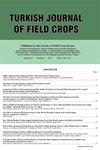THE EFFECTS OF DIFFERENT SOWING TIMES ON THE PHENOLOGICAL CHARACTERISTICS AND SEED YIELD OF THE PEA
IF 0.8
4区 农林科学
Q3 AGRONOMY
引用次数: 0
Abstract
The pea is a legume with a high protein content and high nutritional value. In recent times, it has come to be consumed as a frozen and canned food as well as fresh. It has a special place among legumes because of its suitability for crop rotation. In Turkey, it is mostly grown as a winter crop in the western regions. Planting takes place in the fall for the winter growing season. Determining the best sowing time is vital to avoid cold damage. This study was conducted over two years in the 2020-21 and 2021-22 growing seasons in the field crops trial fields of Aydin Adnan Menderes University Faculty of Agriculture. During the study, the dry matter values and GDD (growing degree days) of four pea cultivars (Giresun, Mayer, local 1 and local 2) were calculated at four phenological periods (emergence, flowering, pod set and maturity) for three different sowing dates (November 1, November 20 and December 10). In addition, the yield and yield characteristics and protein content were analyzed. Among the four varieties, Mayer (1.95t ha-1) recorded the highest yield value, while Giresun (25.6%) achieved the highest protein content. The number of days to maturity, dry matter content and GDD values of the varieties at the different phenological periods varied with the sowing date. Higher GDD and dry matter content levels were measured in early sowing. The later the sowing, the shorter the period from pod set to maturation and the lower the dry matter content.不同播种时间对豌豆物候特征和种子产量的影响
豌豆是一种豆科植物,蛋白质含量高,营养价值高。近来,豌豆开始作为冷冻和罐装食品以及新鲜食品食用。由于适合轮作,豌豆在豆科植物中占有特殊地位。在土耳其西部地区,它主要作为冬季作物种植。秋季播种,冬季生长。确定最佳播种时间对于避免冷害至关重要。这项研究在艾登阿德南-门德斯大学农学院的大田作物试验田进行,为期两年,分别在 2020-21 和 2021-22 两个生长季节进行。研究期间,计算了四个豌豆栽培品种(Giresun、Mayer、本地 1 号和本地 2 号)在三个不同播种日期(11 月 1 日、11 月 20 日和 12 月 10 日)的四个物候期(出苗、开花、结荚和成熟)的干物质值和 GDD(生长度日)。此外,还分析了产量、产量特征和蛋白质含量。在四个品种中,Mayer(1.95 吨/公顷-1)的产量最高,而 Giresun(25.6%)的蛋白质含量最高。各品种在不同物候期的成熟天数、干物质含量和 GDD 值随播种日期而变化。播种早的品种 GDD 和干物质含量较高。播种越晚,从结荚到成熟的时间越短,干物质含量越低。
本文章由计算机程序翻译,如有差异,请以英文原文为准。
求助全文
约1分钟内获得全文
求助全文
来源期刊

Turkish Journal of Field Crops
AGRONOMY-
CiteScore
1.50
自引率
12.50%
发文量
21
审稿时长
>12 weeks
期刊介绍:
Information not localized
 求助内容:
求助内容: 应助结果提醒方式:
应助结果提醒方式:


